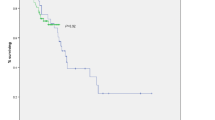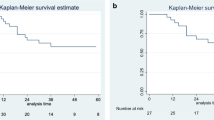Abstract
Background
Pseudomyxoma peritonei (PMP) is a rare clinical presentation, with considerable morbidity and mortality if left untreated. In recent decades, there is growing acceptance for the use of cytoreductive surgery (CRS) with heated intraperitoneal chemotherapy (HIPEC). The aim of this study was to report on our 10-year single-center experience on outcomes following CRS and HIPEC for PMP of appendiceal origin.
Methods
A retrospective analysis of a prospectively maintained database of all patients undergoing CRS and HIPEC for PMP of appendiceal origin over a 10-year period at a statewide referral center was conducted.
Results
One hundred and seventy-five cytoreductive procedures were undertaken in 140 patients. The mean patient age was 57.4 years, with a female preponderance (56%). The median PCI was 16, with 73.1% of cases having a complete cytoreduction. Grade III/IV complications occurred in 36 (20.6%) cases, with no mortalities. The median overall and disease-free survival was 100 months and 40 months, respectively, with a 71% 5-year survival. High-grade histology was the main factor identified as an independent predictor of worse overall survival.
Conclusion
CRS and HIPEC are safe with acceptable rates of morbidity. It can provide very favorable survival in patients with PMP. High-grade histology is a key prognostic factor associated with a worse overall survival.




Similar content being viewed by others
References
Hinson FL, Ambrose NS: Pseudomyxoma peritonei. Br J Surg 85:1332–9, 1998
Smeenk RM, van Velthuysen ML, Verwaal VJ, et al: Appendiceal neoplasms and pseudomyxoma peritonei: a population based study. Eur J Surg Oncol 34:196–201, 2008
Esquivel J, Sugarbaker PH: Clinical presentation of the pseudomyxoma peritonei syndrome. Br J Surg 87:1414–8, 2000
Carr NJ, Emory TS, Sobin LH: Epithelial neoplasms of the appendix and colorectum: an analysis of cell proliferation, apoptosis, and expression of p53, CD44, bcl-2. Arch Pathol Lab Med 126:837–41, 2002
Agrawal AK, Bobinski P, Grzebieniak Z, et al: Pseudomyxoma peritonei originating from urachus-case report and review of the literature. Curr Oncol 21:e155–65, 2014
Higa E, Rosai J, Pizzimbono CA, et al: Mucosal hyperplasia, mucinous cystadenoma, and mucinous cystadenocarcinoma of the appendix. A re-evaluation of appendiceal “mucocele”. Cancer 32:1525–41, 1973
Wolff M, Ahmed N: Epithelial neoplasms of the vermiform appendix (exclusive of carcinoid). II. Cystadenomas, papillary adenomas, and adenomatous polyps of the appendix. Cancer 37:2511–22, 1976
Foster JM, Gupta PK, Carreau JH, et al: Right hemicolectomy is not routinely indicated in pseudomyxoma peritonei. Am Surg 78:171–7, 2012
Miner TJ, Shia J, Jaques DP, et al: Long-term survival following treatment of pseudomyxoma peritonei: an analysis of surgical therapy. Ann Surg 241:300–8, 2005
Gough DB, Donohue JH, Schutt AJ, et al: Pseudomyxoma peritonei. Long-term patient survival with an aggressive regional approach. Ann Surg 219:112–9, 1994
Mann WJ, Jr., Wagner J, Chumas J, et al: The management of pseudomyxoma peritonei. Cancer 66:1636–40, 1990
Sugarbaker PH: Management of peritoneal carcinomatosis. Acta Med Austriaca 16:57–60, 1989
Sugarbaker PH, Ryan DP: Cytoreductive surgery plus hyperthermic perioperative chemotherapy to treat peritoneal metastases from colorectal cancer: standard of care or an experimental approach? Lancet Oncol 13:e362–9, 2012
Los G, Mutsaers PH, Lenglet WJ, et al: Platinum distribution in intraperitoneal tumors after intraperitoneal cisplatin treatment. Cancer Chemother Pharmacol 25:389–94, 1990
Moran B, Baratti D, Yan T, et al: Consensus statement on the loco-regional treatment of appendiceal mucinous neoplasms with peritoneal dissemination (pseudomyxoma peritonei). Journal of Surgical Oncology 98:277–282, 2008
Chua TC, Moran BJ, Sugarbaker PH, et al: Early- and long-term outcome data of patients with pseudomyxoma peritonei from appendiceal origin treated by a strategy of cytoreductive surgery and hyperthermic intraperitoneal chemotherapy. J Clin Oncol 30:2449–56, 2012
Chua TC, Yan TD, Smigielski ME, et al: Long-term survival in patients with pseudomyxoma peritonei treated with cytoreductive surgery and perioperative intraperitoneal chemotherapy: 10 years of experience from a single institution. Ann Surg Oncol 16:1903–11, 2009
Elias D, Gilly F, Quenet F, et al: Pseudomyxoma peritonei: a French multicentric study of 301 patients treated with cytoreductive surgery and intraperitoneal chemotherapy. Eur J Surg Oncol 36:456–62, 2010
Youssef H, Newman C, Chandrakumaran K, et al: Operative findings, early complications, and long-term survival in 456 patients with pseudomyxoma peritonei syndrome of appendiceal origin. Dis Colon Rectum 54:293–9, 2011
Deraco M, Kusamura S, Laterza B, et al: Cytoreductive surgery and hyperthermic intra-peritoneal chemotherapy (HIPEC) in the treatment of pseudomyxoma peritonei: ten years experience in a single center. In Vivo 20:773–6, 2006
Bradley RF, Stewart JHt, Russell GB, et al: Pseudomyxoma peritonei of appendiceal origin: a clinicopathologic analysis of 101 patients uniformly treated at a single institution, with literature review. Am J Surg Pathol 30:551–9, 2006
Rizvi SA, Syed W, Shergill R: Approach to pseudomyxoma peritonei. World J Gastrointest Surg 10:49–56, 2018
Faris JE, Ryan DP: Controversy and consensus on the management of patients with pseudomyxoma peritonei. Curr Treat Options Oncol 14:365–73, 2013
Pai RK, Longacre TA: Appendiceal mucinous tumors and pseudomyxoma peritonei: histologic features, diagnostic problems, and proposed classification. Adv Anat Pathol 12:291–311, 2005
Reu S, Neumann J, Kirchner T: Mucinous neoplasms of the vermiform appendix, pseudomyxoma peritonei, and the new WHO classification. Pathologe 33:24–30, 2012
Ronnett BM, Zahn CM, Kurman RJ, et al: Disseminated peritoneal adenomucinosis and peritoneal mucinous carcinomatosis. A clinicopathologic analysis of 109 cases with emphasis on distinguishing pathologic features, site of origin, prognosis, and relationship to “pseudomyxoma peritonei”. Am J Surg Pathol 19:1390–408, 1995
Carr NJ, Cecil TD, Mohamed F, et al: A consensus for classification and pathologic reporting of pseudomyxoma peritonei and associated appendiceal neoplasia: the results of the Peritoneal Surface Oncology Group International (PSOGI) Modified Delphi Process. Am J Surg Pathol 40:14–26, 2016
Carr NJ, Bibeau F, Bradley RF, et al: The histopathological classification, diagnosis and differential diagnosis of mucinous appendiceal neoplasms, appendiceal adenocarcinomas and pseudomyxoma peritonei. Histopathology 71:847–858, 2017
Sugarbaker PH: Cytoreductive surgery and peri-operative intraperitoneal chemotherapy as a curative approach to pseudomyxoma peritonei syndrome. Eur J Surg Oncol 27:239–43, 2001
Sugarbaker PH, Kern K, Lack E: Malignant pseudomyxoma peritonei of colonic origin. Natural history and presentation of a curative approach to treatment. Dis Colon Rectum 30:772–9, 1987
Huang Y, Alzahrani NA, Chua TC, et al: Histological subtype remains a significant prognostic factor for survival outcomes in patients with appendiceal mucinous neoplasm with peritoneal dissemination. Dis Colon Rectum 60:360–367, 2017
Wagner PL, Jones D, Aronova A, et al: Early postoperative intraperitoneal chemotherapy following cytoreductive surgery for appendiceal mucinous neoplasms with isolated peritoneal metastasis. Dis Colon Rectum 55:407–15, 2012
Yan TD, Black D, Savady R, et al: A systematic review on the efficacy of cytoreductive surgery and perioperative intraperitoneal chemotherapy for pseudomyxoma peritonei. Ann Surg Oncol 14:484–92, 2007
Lord AC, Shihab O, Chandrakumaran K, et al: Recurrence and outcome after complete tumour removal and hyperthermic intraperitoneal chemotherapy in 512 patients with pseudomyxoma peritonei from perforated appendiceal mucinous tumours. Eur J Surg Oncol 41:396–9, 2015
Culliford ATt, Brooks AD, Sharma S, et al: Surgical debulking and intraperitoneal chemotherapy for established peritoneal metastases from colon and appendix cancer. Ann Surg Oncol 8:787–95, 2001
Smeenk RM, Verwaal VJ, Antonini N, et al: Survival analysis of pseudomyxoma peritonei patients treated by cytoreductive surgery and hyperthermic intraperitoneal chemotherapy. Ann Surg 245:104–9, 2007
Carr NJ, Finch J, Ilesley IC, et al: Pathology and prognosis in pseudomyxoma peritonei: a review of 274 cases. J Clin Pathol 65:919–23, 2012
Di Fabio F, Mehta A, Chandrakumaran K, et al: Advanced pseudomyxoma peritonei requiring gastrectomy to achieve complete cytoreduction results in good long-term oncologic outcomes. Ann Surg Oncol 23:4316–4321, 2016
Sugarbaker PH: New standard of care for appendiceal epithelial neoplasms and pseudomyxoma peritonei syndrome? Lancet Oncol 7:69–76, 2006
Chua TC, Liauw W, Zhao J, et al: Upfront compared to delayed cytoreductive surgery and perioperative intraperitoneal chemotherapy for pseudomyxoma peritonei is associated with considerably lower perioperative morbidity and recurrence rate. Ann Surg 253:769–73, 2011
Desantis M, Bernard JL, Casanova V, et al: Morbidity, mortality, and oncological outcomes of 401 consecutive cytoreductive procedures with hyperthermic intraperitoneal chemotherapy (HIPEC). Langenbecks Arch Surg 400:37–48, 2015
Jarvinen P, Kivela AJ, Nummela P, et al: Carbonic anhydrase II: a novel biomarker for pseudomyxoma peritonei. APMIS 125:207–212, 2017
Aberle MR, Burkhart RA, Tiriac H, et al: Patient-derived organoid models help define personalized management of gastrointestinal cancer. Br J Surg 105:e48-e60, 2018
Pillai K, Akhter J, Chua TC, et al: Potential mucolytic agents for mucinous ascites from pseudomyxoma peritonei. Invest New Drugs 30:2080–6, 2012
Author information
Authors and Affiliations
Contributions
VN, MM, RR, and AH produced the study concept and design. VN, KW, and MB performed the scientific literature search. VN, KW, and MB did all the data collection. VN performed all the statistical analysis. All authors were involved in refining the study design and data interpretation. VN, KW, SW, CL, MM, JT, CM, TA, RR, and AH wrote the initial draft, with all authors involved in the editing process and final version of the manuscript. All authors have reviewed and approved the final manuscript. All authors agree to be accountable for all aspects of the work.
Corresponding author
Ethics declarations
Conflict of Interest
The authors declare that they have no conflicts of interest.
Additional information
Publisher’s Note
Springer Nature remains neutral with regard to jurisdictional claims in published maps and institutional affiliations.
Rights and permissions
About this article
Cite this article
Narasimhan, V., Wilson, K., Britto, M. et al. Outcomes Following Cytoreduction and HIPEC for Pseudomyxoma Peritonei: 10-Year Experience. J Gastrointest Surg 24, 899–906 (2020). https://doi.org/10.1007/s11605-019-04239-4
Received:
Accepted:
Published:
Issue Date:
DOI: https://doi.org/10.1007/s11605-019-04239-4




